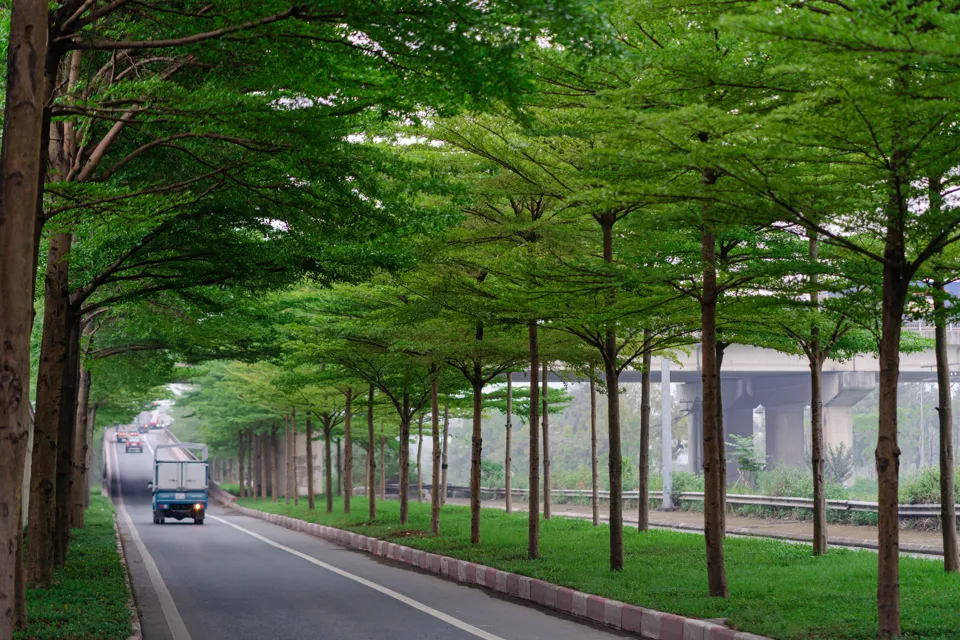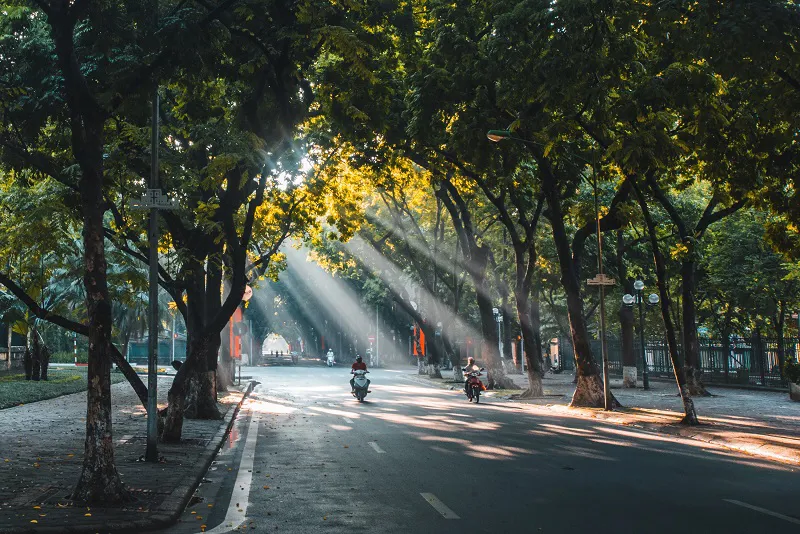Hanoi needs more green, cultural and tourism spaces
The development of green spaces in Hanoi includes green belts, ecological urban areas, flower gardens, and urban landscapes.
In addition to infrastructure to support the sustainable development of cultural industries and the creation of green urban areas, Hanoi should create more green, cultural, and tourism spaces.
National Assembly deputy Phan Duc Hieu made the statement at a recent discussion on the draft Capital City Law (Amended). "Specifically, the historic downtown area needs more public spaces, the proportion of green areas for public use should be increased, cultural and tourism values are to be preserved and promoted, and vacant land left after factories are relocated should not be used for residential purposes," Hieu said.
He added that the rapid and sustainable development of the capital into a green, smart, and modern urban area is a strategy and a key task of the Hanoi government.
Hanoi's Ring Road 2 is lined with rows of verdant small-leaved trees that make for a lovely scene. Photo: Duy Khanh/The Hanoi Times |
"Hanoi has recently focused on the development of green spaces such as parks, gardens, squares, and lakes," said Hieu, praising the city authorities for their attention to detail in restoring and modernizing the parks and flower gardens in the urban core, resulting in typical landscaped spaces for the capital.
He cited same big parks as Thu Le Park and Bach Thao Park in Ba Dinh District, Thong Nhat Park and Tuoi Tre Park in Hai Ba Trung District with an area of 10-50 hectares. “With open space, the flower gardens in Hanoi also contributed to creating landscape and improving the microclimate of the city,” Hieu added.
'Tapping the space of lakes and rivers to create both a unique landscape of the green and ecological capital and resources for sustainable development investment' is one of the five breakthroughs mentioned in the draft direction and vision for the development of Hanoi's capital in the period 2021-2030, with a vision to 2050.
In addition, one of the six development pillars is a circular economy and a green city, where the socio-economic activities of of Hanoi in the period of 2021-2030 has been determined. Green corridors, green belts, green wedges, ecological cities, ecological parks, high-quality agricultural production zones, flower planting areas, and landscape axes are some of the ways Hanoi is developing its green spaces, Hieu noted.
According to a report by the United Nations Educational, Scientific and Cultural Organization (UNESCO), Hanoi has made efforts to expand its green cover from the city center to its suburbs and ring roads, which has helped make the capital one of the most tree-covered cities in the world.
One of the most attractive aspects of Hanoi is the shade provided by its many trees. The city has old tree-lined streets, such as Phan Dinh Phung and Lo Duc, where rows of old trees with thick green foliage tower above the high-rise buildings.
"In recent years, tree-shaded Hanoi has undergone positive changes. The city is more beautiful and greener thanks to rows of beautiful and colorful trees. Some streets have become photogenic spots for young people or destinations for cultural and artistic activities. Hanoi is really much more beautiful now," Nguyen Thi Mai Dung, a resident of Ba Dinh District, told The Hanoi Times.
The golden rays of the sunshine obliquely through the trees, creating a beautiful frame in Phan Dinh Phung Street in Hanoi, one of the greenest, cleanest, and most beautiful streets in the capital city. Photo: Huy Pham/ The Hanoi Times |
Over the past years, Hanoi has planted millions of new trees. In the old streets, whenever an evergreen tree fell, a new sapling was immediately planted to replace it. Many streets have been improved and widened, with greenery covering both sides of the road. Tourists can enjoy the shade of trees on new thoroughfares such as Pham Van Dong, Pham Hung, Le Duc Tho, Hoang Quoc Viet, Vo Chi Cong, Vo Nguyen Giap, and others.
"I think the urban trees planted in Hanoi's streets are suitable for the city's climatic conditions or non-toxic and non-polluting, so the trees will remain a footprint for tourists visiting our capital city," Dung added.
Statistics from the Hanoi Department of Construction show that there are about 1.7 million trees in the city, which provide green spaces, help balance the ecology, and provide a fresh environment for residents.
The department has asked relevant units to draw up an annual plan to plant more trees in urban areas, industrial zones, and along roads and streets on the outskirts of the city to increase tree cover.
"The city has reached its target of planting one million trees by 2020, two years ahead of schedule. Hanoi will plant 500,000 new trees by 2021-2025. Among the trees to be planted this year are orchids, Madagascar almond trees, and giant myrtles. They are being planted for their shade or ornamental value. At present, the tree-planting movement is spreading widely in Hanoi's localities," the department said.
Under the plan, more than 100,000 trees were planted in 2021 and 2022, and around 400,000 more trees are expected to be planted in the next three years. Areas, where new trees will be planted, include traffic projects, parks, and five outlying districts including Thanh Tri, Gia Lam, Dong Anh, Dan Phuong, and Hoai Duc.
As a key unit in planting trees for the city, the Hanoi Green Park Company said that since 2019, it has planted many layers of trees, including many imported trees, to create highlights in key areas, gradually improving the quality of greenery in flower gardens, parks and dividers in the city.
Dr. Ngo Quang De from the University of Forestry welcomed Hanoi's recent tree-planting initiatives. "Planting trees not only helps to green the city, regulate the air and improve the environment but also contributes to creating a prominent place on every street in Hanoi," De told The Hanoi Times.













